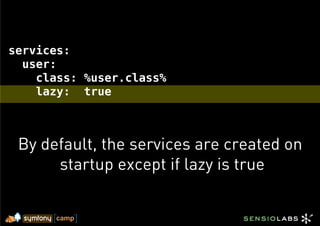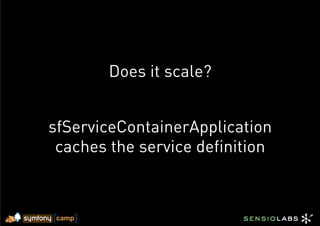Beyond symfony 1.2 (Symfony Camp 2008)
- 1. Beyond symfony 1.2 Fabien Potencier
- 2. Work on symfony 2 started 2 years ago with a brand new code base
- 3. symfony 2 goals Learn from our mistakes Take user feedback into account
- 4. But then, I realized that Starting from scratch is a lot of work! We loose all the debugging we have already done I didn’t want symfony 2 to be the next Perl 6 ;)
- 5. But I learned a lot with this new code I used it to test new ideas… …that were later incorporated into symfony 1 Event dispatcher Form framework
- 6. symfony 2 • symfony 2 will be an evolution of symfony 1, not a revolution • A lot of changes in symfony 1.1 and 1.2 are done to support symfony 2 • symfony 1.1 decoupling was to support symfony 2 • There will be a symfony 1.3
- 7. symfony 2 • Based on the same symfony platform • New libraries / sub-frameworks – Dependency injection container – Real template layer – New controller layer
- 9. The world of programming is evolving fast… very fast But the ultimate goal of these changes is the same
- 10. Build better tools to avoid reinventing the wheel Build on existing code / work / librairies Specialize for your specific needs That’s why Open-Source wins
- 11. Better tools are possible because we base our work on existing work We learn from other projects We can adopt their ideas We can make them better This is the process of evolution
- 12. symfony • PHP – Mojavi : Controller – Propel : ORM – Doctrine : ORM • Ruby – Rails : Helpers, routing • Java – Spring : Dependency injection container • Python – Django : request / response paradigm, controller philosophy • … and much more
- 13. Read code to learn
- 14. This is why Open-Source wins
- 15. Open-Source drives Creativity Innovation
- 16. Create a website • Assembly code • C code • Operating system • MySQL, Apache • PHP • … • Your code
- 17. Create a website • You really need a framework nowadays • But you want it to be flexible and customizable • The framework needs to find the sweet spot – Features / Complexity – Easyness / Extensibility • Each version of symfony tries to be closer to this sweet spot • I hope symfony 2 will be the one • A framework is all about reusability
- 18. Reusability Customization / Extension Configuration Documentation / Support
- 21. In symfony, you manipulate a User object – To manage the user culture – To authenticate the user – To manage her credentials – … – setCulture(), getCulture() – isAuthenticated() – addCredential() – …
- 22. The User information need to be persisted between HTTP requests We use the PHP session for the Storage
- 23. <?php class User { protected $storage; function __construct() { $this->storage = new SessionStorage(); } } $user = new User();
- 24. I want to change the session cookie name
- 25. <?php class User { protected $storage; Add a global Configuration? function __construct() { $this->storage = new SessionStorage(); } } sfConfig::set('storage_session_name', 'SESSION_ID'); $user = new User();
- 26. <?php Configure via class User User? { protected $storage; function __construct($sessionName) { $this->storage = new SessionStorage($sessionName); } } $user = new User('SESSION_ID');
- 27. <?php Configure with class User an array { protected $storage; function __construct($options) { $this->storage = new SessionStorage($options); } } $user = new User( array('session_name' => 'SESSION_ID') );
- 28. I want to change the session storage engine Filesystem MySQL SQLite …
- 29. <?php class User Use a global { context object? protected $storage; function __construct() { $this->storage = Context::get('session_storage'); } } $user = new User();
- 30. The User now depends on the Context
- 31. Instead of harcoding the Storage dependency in the User class Inject the storage dependency in the User object
- 32. <?php class User { protected $storage; function __construct(StorageInterface $storage) { $this->storage = $storage; } } $storage = new Storage( array('session_name' => 'SESSION_ID') ); $user = new User($storage);
- 33. Use built-in Storage strategies Configuration becomes natural Wrap third-party classes (Adapter) Mock the Storage object (for test) Easy without changing the User class
- 34. That’s Dependency Injection Nothing more
- 35. « Dependency Injection is where components are given their dependencies through their constructors, methods, or directly into fields. » http://www.picocontainer.org/injection.html
- 36. Configurable Extensible Decoupled Reusable
- 37. symfony platform
- 38. <?php $dispatcher = new sfEventDispatcher(); $request = new sfWebRequest($dispatcher); $response = new sfWebResponse($dispatcher); $storage = new sfSessionStorage( array('session_name' => 'symfony') ); $user = new sfUser($dispatcher, $storage); $cache = new sfFileCache( array('dir' => dirname(__FILE__).'/cache') ); $routing = new sfPatternRouting($dispatcher, $cache);
- 39. <?php class Application { function __construct() { $this->dispatcher = new sfEventDispatcher(); $this->request = new sfWebRequest($this->dispatcher); $this->response = new sfWebResponse($this->dispatcher); $this->storage = new sfSessionStorage( array('session_name' => 'symfony') ); $this->user = new sfUser($this->disptacher, $this->storage); $this->cache = new sfFileCache( array('dir' => dirname(__FILE__).'/cache') ); $this->routing = new sfPatternRouting($this->disptacher, $this->cache); } } $application = new Application();
- 40. Back to square 1
- 41. We need a Container Describe objects and their relationships Configure them Instantiate them
- 42. Dependency Injection in symfony 2 sfServiceContainer
- 43. <?php $container = new sfServiceContainer(array( 'dispatcher' => new sfServiceDefinition('sfEventDispatcher'), )); $dispatcher = $container->getService('dispatcher'); It is a just a Service Locator?
- 44. <?php $dispatcherDef = new sfServiceDefinition('sfEventDispatcher'); $requestDef = new sfServiceDefinition('sfWebRequest', array(new sfServiceReference('dispatcher')) ); $container = new sfServiceContainer(array( 'dispatcher' => $dispatcherDef, 'request' => $requestDef, )); $request = $container->getService('request');
- 45. $request = $container->getService('request'); Get the configuration for the request service The sfWebRequest constructor must be given a dispatcher service Get the dispatcher object from the container Create a sfWebRequest object by passing the constructor arguments
- 46. $request = $container->getService('request'); is roughly equivalent to $dispatcher = new sfEventDispatcher(); $request = new sfWebRequest($dispatcher);
- 47. <?php $container = new sfServiceContainer(array( 'dispatcher' => new sfServiceDefinition('sfEventDispatcher’), 'request' => new sfServiceDefinition('sfWebRequest', PHP array(new sfServiceReference('dispatcher')) = ), )); <service id="dispatcher" class="sfEventDispatcher" /> <service id="request" class="sfWebRequest"> <constructor_arg type="service" id="dispatcher" /> XML = </service> dispatcher: class: sfEventDispatcher request: class: sfWebRequest YAML constructor_args: [@dispatcher]
- 48. <?php $container = new sfServiceContainer(array( 'dispatcher' => new sfServiceDefinition('sfEventDispatcher'), )); <parameter key="dispatcher.class">sfEventDispatcher</parameter> <service id="dispatcher" class="%dispatcher.class%" /> parameters: dispatcher.class: sfEventDispatcher services: dispatcher: class: %dispatcher.class%
- 49. <parameter key="core.with_logging">true</parameter> <parameter key="core.charset">UTF-8</parameter> <parameter key="response.class">sfWebResponse</parameter> <service id="response" class="%response.class%" global="false"> <constructor_arg type="service" id="event_dispatcher" /> <constructor_arg type="collection"> <arg key="logging">%core.with_logging%</arg> <arg key="charset">%core.charset%</arg> </constructor_arg> </service> parameters: core.with_logging: true core.charset: UTF-8 response.class: sfWebResponse services: response: class: %response.class% global: false constructor_args: - @event_dispatcher - [logging: %core.with_logging%, charset: %core.charset%]
- 50. // YML $loader = new sfServiceLoaderYml(array('/paths/to/config/dir')); list($definitions, $parameters) = $loader->load('/paths/to/yml'); // XML $loader = new sfServiceLoaderXml(array('/paths/to/config/dir')); list($definitions, $parameters) = $loader->load('/paths/to/xml'); // Create the container $container = new sfServiceContainer($definitions, $parameters);
- 51. // Access parameters $withLogging = $container['core.with_logging']; // Access services $response = $container->response;
- 52. <import resource="core.xml" /> <parameter key="dispatcher.class">sfEventDispatcher</parameter> <service id="dispatcher" class="%disaptcher.class%" /> <import resource="app_dev.xml" /> imports_1: core.xml parameters: dispatcher.class: sfEventDispatcher services: dispatcher: class: %dispatcher.class% imports_2: app_dev.xml
- 53. sfServiceContainer replaces several symfony 1.X concepts – sfContext – sfConfiguration – sfConfig – factories.yml – settings.yml / logging.yml / i18n.yml Into one integrated system
- 54. services: response: class: %response.class% global: false Each time you ask for a response object, you get a new one
- 55. services: user: class: %user.class% lazy: true By default, the services are created on startup except if lazy is true
- 56. Does it scale? sfServiceContainerApplication caches the service definition
- 57. Questions?
- 58. Sensio S.A. 92-98, boulevard Victor Hugo 92 115 Clichy Cedex FRANCE Tél. : +33 1 40 99 80 80 Contact Fabien Potencier [email protected] http://www.sensiolabs.com/ http://www.symfony-project.org/















































![<?php
$container = new sfServiceContainer(array(
'dispatcher' => new sfServiceDefinition('sfEventDispatcher’),
'request' => new sfServiceDefinition('sfWebRequest', PHP
array(new sfServiceReference('dispatcher'))
=
),
));
<service id="dispatcher" class="sfEventDispatcher" />
<service id="request" class="sfWebRequest">
<constructor_arg type="service" id="dispatcher" />
XML
=
</service>
dispatcher:
class: sfEventDispatcher
request:
class: sfWebRequest YAML
constructor_args: [@dispatcher]](https://image.slidesharecdn.com/symfony-camp-2008-beyond-1-2-090909074500-phpapp01/85/Beyond-symfony-1-2-Symfony-Camp-2008-47-320.jpg)

![<parameter key="core.with_logging">true</parameter>
<parameter key="core.charset">UTF-8</parameter>
<parameter key="response.class">sfWebResponse</parameter>
<service id="response" class="%response.class%" global="false">
<constructor_arg type="service" id="event_dispatcher" />
<constructor_arg type="collection">
<arg key="logging">%core.with_logging%</arg>
<arg key="charset">%core.charset%</arg>
</constructor_arg>
</service>
parameters:
core.with_logging: true
core.charset: UTF-8
response.class: sfWebResponse
services:
response:
class: %response.class%
global: false
constructor_args:
- @event_dispatcher
- [logging: %core.with_logging%, charset: %core.charset%]](https://image.slidesharecdn.com/symfony-camp-2008-beyond-1-2-090909074500-phpapp01/85/Beyond-symfony-1-2-Symfony-Camp-2008-49-320.jpg)

![// Access parameters
$withLogging = $container['core.with_logging'];
// Access services
$response = $container->response;](https://image.slidesharecdn.com/symfony-camp-2008-beyond-1-2-090909074500-phpapp01/85/Beyond-symfony-1-2-Symfony-Camp-2008-51-320.jpg)






